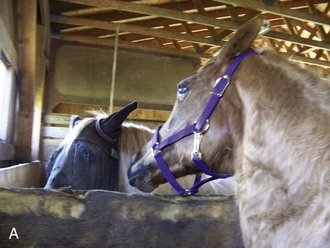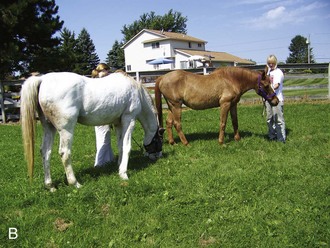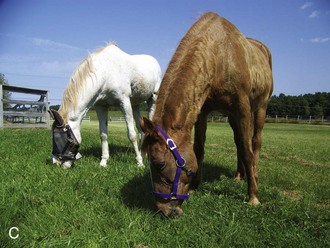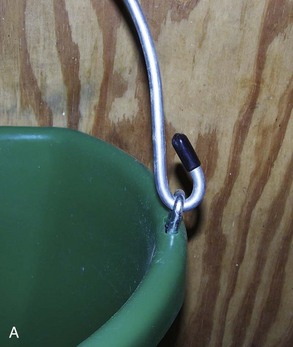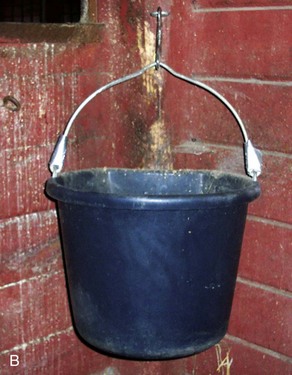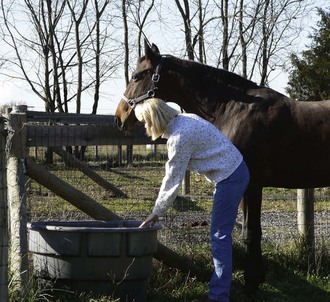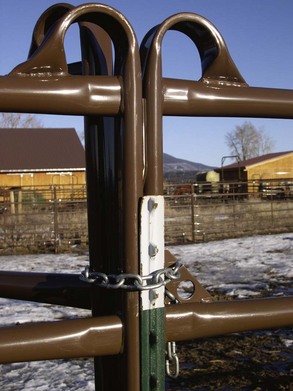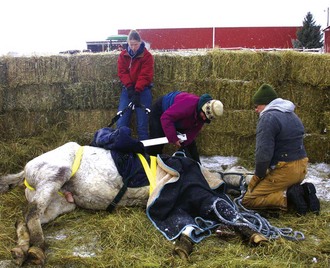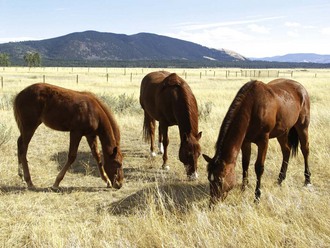Chapter 14 Practical Management of Blind Horses
Several facts are of concern if vision loss is imminent:
Adaptation to Blindness: Give Them Time
When vision finally fails, caretakers report that blind horses go through a transition period where their behavior is unpredictable, reflecting fear and anxiety.1,2 Rapid circling, “freezing” in place, prolonged neighing, spooking, and aggressive body motions (e.g., crashing into walls, running over a handler) may be observed. This initial adjustment period can be dangerous to both the horse and handler, but it is usually transient, lasting anywhere from a few days to several weeks. Cautious handling, patience, and common sense are needed to help the horse adjust to vision loss during this critical period. Newly blind horses should be housed in a corral or stall to allow close monitoring. Blind horses should NOT be turned out in herds. They will do best if they are initially kept by themselves or turned out with a single carefully chosen companion such as a quiet horse, goat, or donkey. It may be helpful to hang a bell on the halter or neck strap of the companion (Fig. 14-1, A).
Anxious blind horses appear to be settled by the voice, smell, and touch of people they knew and trusted when they had sight (see Fig. 14-1, B). While the transition/adaptation period is NOT a time to try to train a blind horse to do new things, frequent handling and attention are appropriate. All owners report that talking is a key part of blind-horse management. The constant murmur of a handler’s voice provides reassurance, lets the horse know where the handler is, and avoids surprise. Handlers also report that frequent touch is calming and comforting to blind horses. They enjoy grooming and petting and will soon learn that the tactile signals of a trusted handler indicate a safe place.
Over several weeks, acceptance of vision loss and adjustment to blindness occurs in most innately calm horses, and behavior becomes settled and predictable (see Fig. 14-1, C) Well-adapted blind horses tend to be cautious and careful and do not have a higher rate of injury than sighted horses. Steve Smith of Rolling Dog Ranch, a sanctuary for disabled animals that houses over 20 blind horses in Montana, sums up the formula for managing blind horses as follows:
Common Sense Safety Concerns
A safe environment is important because blind horses can easily be traumatized. Walls and fences should be smooth and free of nails, sharp pieces of wood, or projecting pieces of wire. Stall entry and exit will be easiest if the stall has a sliding door or a door that swings out into the aisle. All hardware should be free of any sharp or hooklike projections. The J-shaped handles of water buckets should be taped over; these often become gapped with use, presenting a hazard that can trap and tear an eyelid (Fig. 14-2).
The decision to turn a blind horse out into a pasture once it has adapted to vision loss is dependent on the horse and the safety of the pasture. It is a good idea to walk a horse around the perimeter of any new pasture to introduce it to the new space. The process of “mental mapping” may be aided if the handler taps on the fence as it is circumnavigated. Extra time should be spent at the water trough and gate (Fig. 14-3). Audible signals like swishing the water and rapping on the gate will help the horse locate the key features of the pasture.2,4
The footing of all enclosure(s) should be level and free of holes. Obstacles like mounting blocks, jumps, or farm equipment should be removed. Corral or paddock fencing must be horse-safe. Post and pole, split rail, plastic or wooden boards, woven wire mesh, or metal pipe panels are good choices for fence boundaries (Fig. 14-4). Barbed wire and electric wire fences are inappropriate. Wire barbs pose obvious safety hazards, and the electric shock transmitted from electrified wire can panic a blind horse, causing it to run through the fence. If smooth-wire strand fencing is the only option, strips of fabric can be tied to the wire at 6- to 8-foot intervals. The strips will flutter in the wind and the associated noise will aid the horse in respecting the fence boundary.
Tree branches, holes, ponds, ditches, insecure fencing, and farm equipment are obvious hazards that should be eliminated if possible. Immovable vertical obstacles like trees or poles can be made safe if they are rimmed with tires filled with sand or marked by spreading an apron of gravel or rock around their base. The water trough should be located along the fence line and should not contain any sharp corners or rough edges. Seasonal hazards must be taken into consideration. Very wet weather can create dangerous bogs or high water in pasture creeks, and very cold weather paired with freezing rain can create ice patches that are treacherous for blind horses (Fig. 14-5).
Decision Making for Owners
All horses making the adjustment to sight loss require plenty of patience from their owners. Most horses adjust and accept sight loss over a period of several days to several weeks, but some may require several months for full adaptation. Owners who provide a safe environment and practice good common sense find that the majority of blind horses adapt and can eventually be managed with about the same effort and expense sighted horses require (Box 14-1). However, a minority of horses do not adjust well to blindness, even when circumstances are ideal.
Box 14-1 | Common-Sense Tips for Managing Blind Horses
Veterinarians can provide the following list of tips to owners of blind horses:
In other instances, owners may not have the resources to provide a suitable environment for a sightless horse. Some of these animals are donated to sanctuaries or placed in foster homes, and some are euthanized. Ultimately, individual circumstances will dictate the choices made in managing every horse that loses sight (Fig. 14-6).
Bullies and Buddies: Social Interactions with Other Horses
However, horses are social individuals and are usually happiest if they have a companion. Many calm horses are well suited to a “buddy” role for a blind horse. By all reports, bonding between two well-matched horses usually develops quickly. Once a compatible pair has been identified, the two equine friends can be turned out in their own enclosure and will be content to live together as a pair (Fig. 14-7
Stay updated, free articles. Join our Telegram channel

Full access? Get Clinical Tree


